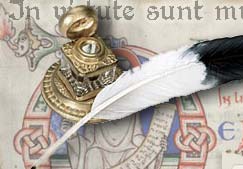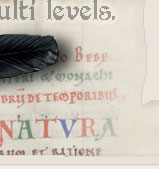|
Pages: 1 2 3 4 [5] 6 7 8 9 10
41
Kryptos means hidden in Greek, The Sculpture...(in my opinion) it is a piece of artwork and is designed to hide the element of human curiosity from the final solution. The solution to Part 4 of the sculpture is hidden from view...in the absence/illusion of light. My guess is that the morse codes found around the sculpture are the final clues when factored in with the other three solutions. Its like a riddle. My first guess tho was that this sculpture had multiple purposes as does all art. First there are many literary transpositions, most important of all is the first sentence. That is the plot, The morse codes are partially hidden and partially complete. "T is your position" alluding to "what? is you position". Second Mistakes were made and hints were given away, "berlin=NYPVTT" My last and final interest is to measure the the shadow cast by the statue based on a four point compass to SEE if the shadow falls onto a CLUE or object during the day and at night. The obvious answer to PART 4 has to do with BERLIN and all the other solutions references. The key is the cipher! Also the four quadrants (squares) of the sculpture could reference to a geometric cipher, I was always intrigued by this statue/sculpture and its reference to the word hidden! (Its a Geometric Cipher)(Something only an Artist could make) on a side note I myself use it as a (public key) HINT! Its was meant to be private. No public eyes! anyways thats were I'm at I haven't bothered finding which geometric cipher was used i'm guessing a private one.
42
« Last post by Cat on July 20, 2013, 06:59:22 AM »
True . . . (After figuring that out the "hard" way 
43
« Last post by Aaron on July 19, 2013, 10:01:38 PM »
I doubt playing connect the dots would reveal anything... that requires too much creative interpretation and is prone to "filling in the gaps" with our own preconceptions. If that were really intended I think the symbols would have been more regularly spaced in a grid-like fashion.
44
« Last post by Cat on July 19, 2013, 09:15:50 PM »
I am taking notes on what both of you say, and am grateful for the help. I just had a wild idea -- what happens when the lines are extended so that they cross or just intersect other lines? Would we have an elaborate dot-to-dot picture that then resolves into a message spelled with the regular alphabet, or would there be a picture? How would it look if we did experiment with putting in the "note lengths"?
45
« Last post by Aaron on July 19, 2013, 01:55:52 AM »
Or perhaps it's a very simple melody in which the number of curls denotes note length?
46
I did look into the music idea a while ago.
Some notes: yes, Cat, you're right that C# and D- are the same note, but a composer would use either one or the other -- they don't mix sharps and flats in a key (it's one or the other).
Second, we resolve to root, whatever that happens to be. And we should find the third, fourth, fifth and root (or octave of these) most prominent in a frequency analysis.
There are some very specific rules for melody in counterpoint, but I don't know these at the moment. I am taking a course in this soonish.
If this is a melody, it is a melody with the note lengths removed. Perhaps that is the puzzle part (after decryption).
47
« Last post by Aaron on July 15, 2013, 05:49:20 PM »
7 white keys, 5 black keys per octave means the whole cipher could be 2 octaves on a piano precisely. Which fits with Elgar being a composer and all. I kinda wonder if this was never meant to be a message at all in the first place, but *just* a musical piece (albeit a pretty one I'm sure). The question is how do you map the symbols to the keys? I'd wager that it's either all single loops, all double loops, and then all triple loops in some set rotation order or single-double-triple as rotated in a specific order.
If it is a cipher on top of being a musical piece, I would guess at it being some kind of a rotary cipher vs a plain substitution cipher (aka, 1-1-1-1 would be ABCD).
Based on the way it was written, I'm fairly certain it's intended to be read left to right or perhaps right to left.
48
« Last post by Cat on July 14, 2013, 09:52:27 PM »
You are right -- I should rotate the last shapes properly, and in a certain light while 24 shapes are possible, only 22 are used. I will take a better photo and post to show what I am talking about.
(I am using this frame because it presumes orientation might matter)
For example, in an octive, a note may have 2 names. The black key C-Sharp is also D-Flat. So perhaps we are looking at a cipher where several shapes mean the same thing, only adjusted 8 steps? That would still leave us with a 24 letter Alphabet (8 * 3)
Therefore, we might have a written variation of the following notes starting with a-("a Flat" in the bottom left corner) until we go full circle:
a# B# C# D# E# F# G# A# <--the top level has 3 curls at 8 different *possible* angles
a B C D E F G A <-- the middle level has 2 curls at 8 different angles
a- B- C- D- E- F- G- A- <-- this bottom level has only 1 curl at 8 different angles
*possible because only 6 curls of three are used
So now we start counting down how many notes there really are because *some* notes equal others, and hitting a number like 13 actual would be sweet, because that would mean there was room for 8 white keys and 5 black on a piano.
a# * C# D# * F# G# A#
a B C D E F G A = 15 (sniffle! 2 over --unless the last 2 (A and A#) are nulls)
a- * * * * * * *
Edit:
On second thought, 15 may be just about perfect as well -- because that is 3 ways to symbolize the numbers 1 through 5 for a "5x5", and all the copies as noted when hoping for 8+5 still fill their function . . .
49
« Last post by Aaron on July 14, 2013, 02:54:09 PM »
Yeah, the general consensus seems to be a mix between substitution and cipher, since no matter which way I've written the letters into a substitution solver I didn't get back much of interest. Of course, those solvers assume it's in English...
Also, I can only see 24 shapes in the Dorabella Cipher, which leads me to wonder what 25 and 26 could be, or if a couple letters were simply "left out" of the substitution.
50
« Last post by Cat on July 14, 2013, 01:34:30 AM »
Here is why there are 26 shapes in the Dora Bella cipher, I think. Basically, we are just dealing with embelishments around a a "+" and an "x". That's it. Now if we just knew what the darn thing said . . . 
Pages: 1 2 3 4 [5] 6 7 8 9 10
|



 Recent Posts
Recent Posts

